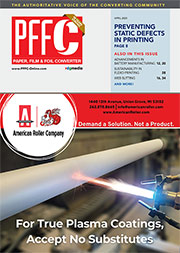Featured Stories
-
Advantages of Shear, Razor and Crush Web Slitting Techniques
When choosing a slitting method, many factors must be considered, including interaction with inspection systems. -
Revolutionizing Lithium-lon Battery Manufacturing Advances in Slot-Die and Electrode Coating Technology
As the global battery market surges toward an estimated $328 billion by 2028, innovations in manufacturing processes are becoming increasingly... -
Nordson Divisions Collaborate to Achieve Unprecedented Flat Profile Time
Nordson Measurement & Control Solutions (a division of Nordson Corporation) is a global leading provider of gauging systems for the film...
News | New Products
-
Morris Packaging to Add New KY Flex-pack Plant
Bloomington, IL-based Morris Packaging plans to build a new $60.9-million production plant in Marion County (KY), a project that will create 276 full-time jobs.
-
Press Belt Manufacturer IPCO to Focus on Engineering and Service Expertise
IPCO will use Ligna 2025 to highlight the service and support services it provides to press manufacturers and WBP producers alike.
-
INX promotes seven Executives to Vice President positions
INX International Ink Co. has announced the Board of Directors has approved the promotions of seven key people to Vice President positions.
-
Bimec and Flex CA Strengthen U.S. Market Presence with a new installation at Cello-Wrap Packaging Inc.
Bimec and Flex CA proudly announce a new milestone in their U.S. market expansion with the recent commissioning of a state-of-the-art slitter rewinder at Cello-Wrap Packaging Inc, located in Farmersville - TX.
-
New Era Converting promotes industry veteran Stephen Pickett to controls engineering manager
New Era Converting, an IPCO company, has announced that Stephen Pickett is taking on a new role as controls engineering manager.
-
Fedrigoni Announces New Slitting Center for Self-Adhesive Labels in Germany in Q4 2025
The Fedrigoni Group - a world reference in the manufacturing of self-adhesive labels, special papers for packaging and other creative applications, graphic supports for visual communication and RFID
-
Advancing Label Innovation Through Collaboration
Packaging is a physical representation of a brand’s identity, and label converters play an essential role in bringing the packaging experience to life.
Expert Advice
Static Beat | Keep a Good Thing Going!
- Published: January 05, 2016, By Dr. Kelly Robinson
Your line is running well. Now you need to maintain good static performance. Here's how.
 Your team has done a great job improving static performance, and the line is running well. It is time to raise the flag, declare victory, and tackle the next pressing problem, right? Well, almost!
Your team has done a great job improving static performance, and the line is running well. It is time to raise the flag, declare victory, and tackle the next pressing problem, right? Well, almost!
Now, we need to maintain good static performance and “Keep a Good Thing Going!”
I offer 11 recommendations in Table I to maintain good control.
| No. | Table I. Recommendations To Maintain Static Control |
| 1 | For a workflow where static is important, devote at least 2% of total work hours to static control. |
| 2 | Train operators on a regular schedule (annually) on static electricity awareness. |
| 3 | Install each static dissipator to have good neutralization efficiency. |
| 4 | Energize active static bars only when the line is running. |
| 5 | Make a checklist with a photo of each static dissipator identifying the location and proper orientation. |
| 6 |
Visually inspect each static dissipator weekly to ensure that it is fit-for-use. By "fit-for-use," I mean 3 things: a. The dissipator is in place and properly spaced. b. The static dissipators are clean and they are in good physical condition. c. Power is applied to active bars. |
| 7 | Measure quarterly the neutralization efficiency of each static dissipator. |
| 8 | Audit the static levels on incoming rolls. |
| 9 | Audit the static levels on finished rolls. |
| 10 | Perform a static survey to qualify lines for service after major maintenance operations. |
| 11 | Perform a static survey as part of Management of Change. |
The first and most important recommendation is to include static control as part of the routine work for the line. Assign static control as part of regular, routine job responsibilities. How much time should be devoted to static control? Of course, this depends on the operation.
 My initial recommendation in Figure 1 is to devote 2% of the scheduled work hours to static control. For example, suppose the work flow involves solution prep, receiving wide rolls, solvent coating, slitting, and customer roll handling and packaging having 9 operators being supported by one process engineer. With 10 workers for each shift, there are 400 work hours scheduled each week. I recommend beginning with assigning 8 hours per week to static control. The process engineer might be assigned 4 hours each week with the additional responsibility for an additional 4 hours delegated to operations for help performing specific tasks and collecting data.
My initial recommendation in Figure 1 is to devote 2% of the scheduled work hours to static control. For example, suppose the work flow involves solution prep, receiving wide rolls, solvent coating, slitting, and customer roll handling and packaging having 9 operators being supported by one process engineer. With 10 workers for each shift, there are 400 work hours scheduled each week. I recommend beginning with assigning 8 hours per week to static control. The process engineer might be assigned 4 hours each week with the additional responsibility for an additional 4 hours delegated to operations for help performing specific tasks and collecting data.
Of course, each material flow operation has its own unique challenges, and the appropriate effort to control static in your operation may be different from 2% of scheduled work hours. However, static control deserves significant attention because static fires occur periodically in our industry, workers suffer injury, and product quality suffers.
My 2% recommendation is based on my estimate for the potential worldwide savings from improved static control in Table II counted in hundreds of millions of dollars. On our current trajectory, the estimated savings from improved static control reach $1B US in a few years. These estimates assume that losses caused by static electricity in our industry are about 1%, which is my personal assessment. The worldwide flexible packaging market in 2011 was about $70B US with an estimated loss from static electricity of $700M US. With growth estimated to be 4.4% per year, the estimated losses from static electricity grow to $1.0B by 2020.
| Table II. Worldwide Flexible Packaging Market | ||
| Year | Total Market | 1% Losses |
| 2011 | $70B | $700M |
| 2012 | $73B | $731M |
| 2013 | $76B | $763M |
| 2014 | $80B | $800M |
| 2015 | $84B | $835M |
| 2016 | $87B | $872M |
| 2017 | $91B | $910M |
| 2018 | $95B | $950M |
| 2019 | $99B |
$992M |
| 2020 | $104B |
$1.0B |
My estimate that static losses are about 1% is based on three things:
- Static fires
- Lost productivity from lower line speeds and re-work caused by static
- Customer problems causing rejected material and lost sales
This estimate is probably conservative. The actual losses may be considerably greater, which increases our urgency for improving static control.
Preventing static fires is an important and difficult static control challenge … probably the greatest static control challenge faced by our industry. While annual losses from static fires are significant, good static control can prevent static fires. I am aware of at least one solvent coater that operated for many years without a single static ignition. Implementing Fault Tolerant Static Control is one, good path to guide our efforts to improve static control with the specific goal of preventing static fires.
Static electricity causes lost productivity. I recently visited an operation where a line was running at half-speed. The line speed was reduced to avoid static problems that occurred at higher speeds. Here, effective static control would enable a significant increase in productivity.
Finished goods are returned as defective material because static electricity causes severe problems in customer applications. My experience is that dissipating static on finished goods is either simply impossible or the re-work operations needed to dissipate the static are more costly than simply replacing the material with an additional production run where good static control has been implemented. In either case, the returned material is 100% waste.
Prevent the human suffering and economic losses from static electricity with devoted effort. Examine your sales and static losses to determine what portion of the estimated hundreds of millions of dollars of annual, worldwide savings are available to your business.
I invite you to ask questions about this column and to suggest future topics. My email address is: This email address is being protected from spambots. You need JavaScript enabled to view it..
Static control expert Dr. Kelly Robinson, president of Electrostatic Answers, has 27+ years of experience in problem-solving and consulting. Kelly writes PFFC's Static Beat column and the Kelly on Static blog. Contact him at 585-425-8158; This email address is being protected from spambots. You need JavaScript enabled to view it.; www.electrostaticanswers.com.













